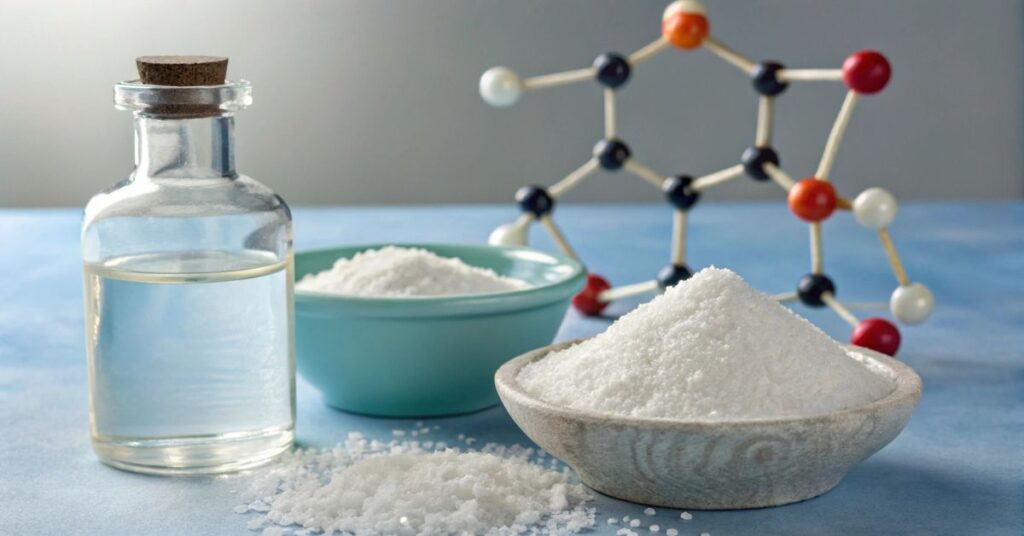Have you ever wondered what makes your eyeglass frames flexible, your favorite silk-like fabric lightweight, or even what gives salt-and-vinegar chips their signature tangy flavor? The answer lies in acetate—a fascinating and widely used compound found in countless industries.
From textiles and medicine to food preservation and industrial applications, acetate plays a crucial role in our daily lives. In this article, we’ll dive deep into what acetate is, how it’s used, its benefits, and why it’s becoming even more popular in sustainable innovations. Whether you’re a science enthusiast, a business professional, or just curious about this compound, you’re in the right place.
So, let’s get started!
What Exactly Is Acetate?

Put simply, acetate is a compound derived from acetic acid (the main component in vinegar). It comes in different forms, primarily salts, esters, and fibers, depending on how it’s processed.
Scientifically, acetate is represented as C₂H₃O₂⁻ and is commonly found in sodium acetate, calcium acetate, and potassium acetate. If that sounds too technical, don’t worry! The important thing to know is that acetate has a wide range of practical applications, which we’ll explore in just a moment.
Key Characteristics of Acetate:
✅ Highly soluble in water and organic solvents
✅ Biodegradable and eco-friendly in many forms
✅ Non-toxic when used in food and medicine
✅ Lightweight and flexible, making it perfect for fashion and industrial use
Chemical Structure and Properties:
- Molecular Formula: C₂H₃O₂⁻
- Molar Mass: ~59.04 g/mol
- Solubility: Highly soluble in water and organic solvents
- Nature: Acetates are generally non-toxic and biodegradable
- Formation: Acetates form when acetic acid reacts with a base, metal, or alcohol
Types of Acetate Compounds:
- Salts of Acetic Acid: Includes sodium acetate, calcium acetate, and potassium acetate.
- Esters of Acetic Acid: Includes ethyl acetate, cellulose acetate, and vinyl acetate.
- Biochemical Acetates: Such as acetyl-CoA, which plays a vital role in metabolism.
Now that you have a basic idea of what acetate is, let’s explore why it’s so useful.
Also Read: Fashion 6 Cell 14.4V 4001mAh-5000mAh HP Computer Battery!
Where Is Acetate Used?

You might be surprised at just how many industries rely on acetate. Here’s a breakdown of its most common applications:
1. Acetate in Medicine and Pharmaceuticals
One of the most important uses of acetate is in medicine. Here’s how it helps:
- IV Fluids & Electrolyte Balance: Sodium acetate is used in intravenous solutions to help maintain a patient’s pH balance and hydration.
- Steroid Medications: Some pharmaceutical drugs, like testosterone acetate, use acetate to help the body absorb the medication efficiently.
- Biochemical Research: Acetate plays a role in buffering solutions, which help scientists maintain the right conditions for experiments.
2. Acetate in Food & Preservation
If you love food that stays fresh for a long time, you can thank acetate!
- Calcium acetate is used in baked goods to help control acidity and maintain freshness.
- Sodium acetate is the secret behind salt-and-vinegar chips, giving them that delicious tangy kick.
- Acetate also helps prevent the growth of harmful bacteria, making it an effective preservative.
3. Acetate in Fashion & Textiles
Acetate fabrics have been a game-changer in the fashion world. Here’s why:
- Cellulose acetate creates soft, luxurious, and breathable fabrics that feel similar to silk.
- Many wedding dresses, evening gowns, and high-end linings are made from acetate fibers.
- It’s also used in eyeglass frames because of its lightweight, flexible, and colorful properties.
4. Acetate in Science & Chemistry
If you’ve ever worked in a lab, you might have used acetate without realizing it.
- Vinyl acetate is a key ingredient in adhesives, paints, and coatings.
- Acetate buffers help maintain the right pH levels in scientific experiments.
- Some forms of acetate are used in chromatography, a process that helps separate different substances for research.
5. Acetate in Manufacturing & Industry
Acetate isn’t just for science and fashion—it plays a big role in industrial applications too.
- Plastic Production: Acetate-based plastics are more environmentally friendly compared to traditional plastic.
- De-icing Agent: Potassium acetate is used as a safer alternative to rock salt for melting ice on roads.
- Eco-Friendly Innovations: Acetate is now being used in biodegradable packaging to reduce plastic waste.
Why Is Acetate So Popular?
At this point, you might be wondering, “What makes acetate better than other materials?” The answer lies in its unique advantages.
The Key Benefits of Acetate:
✔ Eco-Friendly & Biodegradable – Unlike many plastics, acetate-based materials break down naturally.
✔ Safe for Consumption & Medical Use – It’s non-toxic and widely used in food, medicine, and pharmaceuticals.
✔ Lightweight & Durable – Perfect for fashion, eyewear, and industrial uses.
✔ Highly Versatile – Can be used in everything from food preservation to clothing production.
With sustainability becoming a major global priority, acetate is gaining even more attention as an eco-conscious material for the future.
How Is Acetate Made?
The production of acetate depends on its specific form. The two main processes include:
1. Chemical Synthesis of Acetates
- Acetic acid reacts with a base (like sodium hydroxide) to form acetate salts.
- Example reaction:
CH3COOH+NaOH→CH3COONa+H2O
- This reaction is used to produce industrial sodium acetate.
2. Natural Biosynthesis
- Acetate naturally occurs in the body as acetyl-CoA, an essential compound for metabolism.
- It plays a key role in energy production and the synthesis of fatty acids.
In simple terms, whether made in a lab or produced by nature, acetate is an essential part of many biological and industrial processes.
You have to check: How I Sleep at Night Knowing I’m Failing All My Cl – Tymoff
What Is The Difference Between Acetate And Acetic Acid?
Acetate and acetic acid are closely related but have distinct chemical properties and uses. Here’s a clear breakdown of their differences:
| Feature | Acetic Acid (CH₃COOH) | Acetate (C₂H₃O₂⁻) |
| Chemical Structure | Contains a carboxyl (-COOH) functional group | Acetate is the conjugate base or salt of acetic acid |
| pH Level | Acidic in nature (low pH) | Neutral or slightly basic, depending on the salt |
| Formation | A pure compound found in vinegar | Forms when acetic acid loses a hydrogen ion (H⁺) or reacts with a base |
| Solubility | Soluble in water and organic solvents | Highly soluble in water |
| Uses | Found in vinegar, food preservation, and industrial applications | Used in pharmaceuticals, textiles, plastics, and chemical buffers |
| Examples | Vinegar, food additives, cleaning agents | Sodium acetate, calcium acetate, cellulose acetate (used in fabrics and films) |
In Simple Terms:
- Acetic acid is a weak acid that gives vinegar its sour taste and is used in food and industrial applications.
- Acetate is the salt or ester form of acetic acid, often used in medicine, textiles, and biodegradable plastics.
Also Read: Anime:6tbztsekyf0= Sus – Why It’s More Than Just Entertainment!
Future of Acetate – What’s Next?
As industries continue to shift towards sustainable solutions, acetate is expected to play an even bigger role in the future. Some of the latest innovations include:
🌿 Biodegradable Acetate Plastics – A potential game-changer for reducing plastic pollution.
👓 3D-Printed Acetate Eyewear – More sustainable and customizable glasses.
🏥 Medical-Grade Acetates – Improved drug delivery systems and medical coatings.
With new research and advancements, acetate is proving to be a material of the future.
Must Check: White Oak Global Advisors Lawsuit Settlement – Key Takeaways!
Frequently Asked Questions:
1. Is acetate safe for human use?
Yes! Acetate is non-toxic and commonly used in food, medicine, and textiles. However, industrial-grade acetate (like vinyl acetate) should be handled with care.
2. How does acetate compare to plastic?
Acetate is more eco-friendly because it is biodegradable, unlike traditional petroleum-based plastics.
3. Can acetate be recycled?
Yes! Many acetate-based materials, such as eyeglass frames and biodegradable plastics, can be recycled and repurposed.
4. What makes acetate a good material for eyeglasses?
Acetate is lightweight, flexible, and durable, making it an excellent alternative to plastic for high-quality eyewear.
5. What is the environmental impact of acetate?
Unlike many synthetic materials, acetate breaks down naturally in the environment, making it a sustainable choice for various applications.
Conclusion: Why Acetate Matters!
From medicine to fashion, food preservation to scientific research, acetate has cemented itself as a versatile, reliable, and increasingly eco-friendly material. As industries push towards more sustainable solutions, acetate is set to become even more important in the years ahead.
So, the next time you put on your acetate-framed glasses, enjoy a bag of salt-and-vinegar chips, or wear a silky acetate dress, you’ll know exactly why acetate is such a big dea
Latest Post: